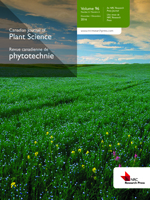Goyal A., Beres, B. L., Randhawa, H. S., Navabi, A., Salmon, D. F. and Eudes, F. 2011. Yield stability analysis of broadly adaptive triticale germplasm in southern and central Alberta, Canada for industrial end-use suitability. Can. J. Plant Sci. 91: 125-135. Triticale (×Triticosecale Wittmack) is a cereal crop with high grain yield and biomass potential, which are traits desired in biorefinery processes that currently utilize wheat (Triticum aestivum). This study was conducted to evaluate the performance of introduced germplasm for its adaptability to selected Canadian prairie agroecosystems, and to benchmark both introduced and registered triticale lines against hard red spring wheat. To investigate the genotype×environment interaction effects on the performance of triticale genotypes, 30 genotypes (27 triticale; 3 hard red spring wheat) were grown in three environments for 3 yr (2005-2007) in southern and central Alberta, Canada. Variance due to genotypes, years, locations, and their interactions were studied by employing several stability analysis models. Site Regression Model (SREG) and GGE biplot analysis were conducted to rank the relative yield performance of cultivars and to identify stable genotypes. Triticale consistently produced higher grain and biomass than hard red spring wheat, but some lines were high in pentosan content, produced low test weight, and possessed unacceptable growing degree day requirements. However, several of the introduction lines displayed superior trait performance and high stability. Five advanced to “C” level registration testing with one subsequently recommended for registration. The results provide evidence that some of the global triticale germplasm are well-suited to the production environments of the Canadian prairies, and that triticale has potential to be the ideal cereal platform for future technological and biorefinery end-use applications.
How to translate text using browser tools
1 January 2011
Yield stability analysis of broadly adaptive triticale germplasm in southern and central Alberta, Canada, for industrial end-use suitability
A. Goyal,
B. L. Beres,
H. S. Randhawa,
A. Navabi,
D. F. Salmon,
F. Eudes
ACCESS THE FULL ARTICLE
It is not available for individual sale.
This article is only available to subscribers.
It is not available for individual sale.
It is not available for individual sale.
×Triticosecale Wittmack
×Triticosecale Wittmack
analyse de la stabilité
blé
Genotype×environment interaction
interaction génotype×environnement
rendement





